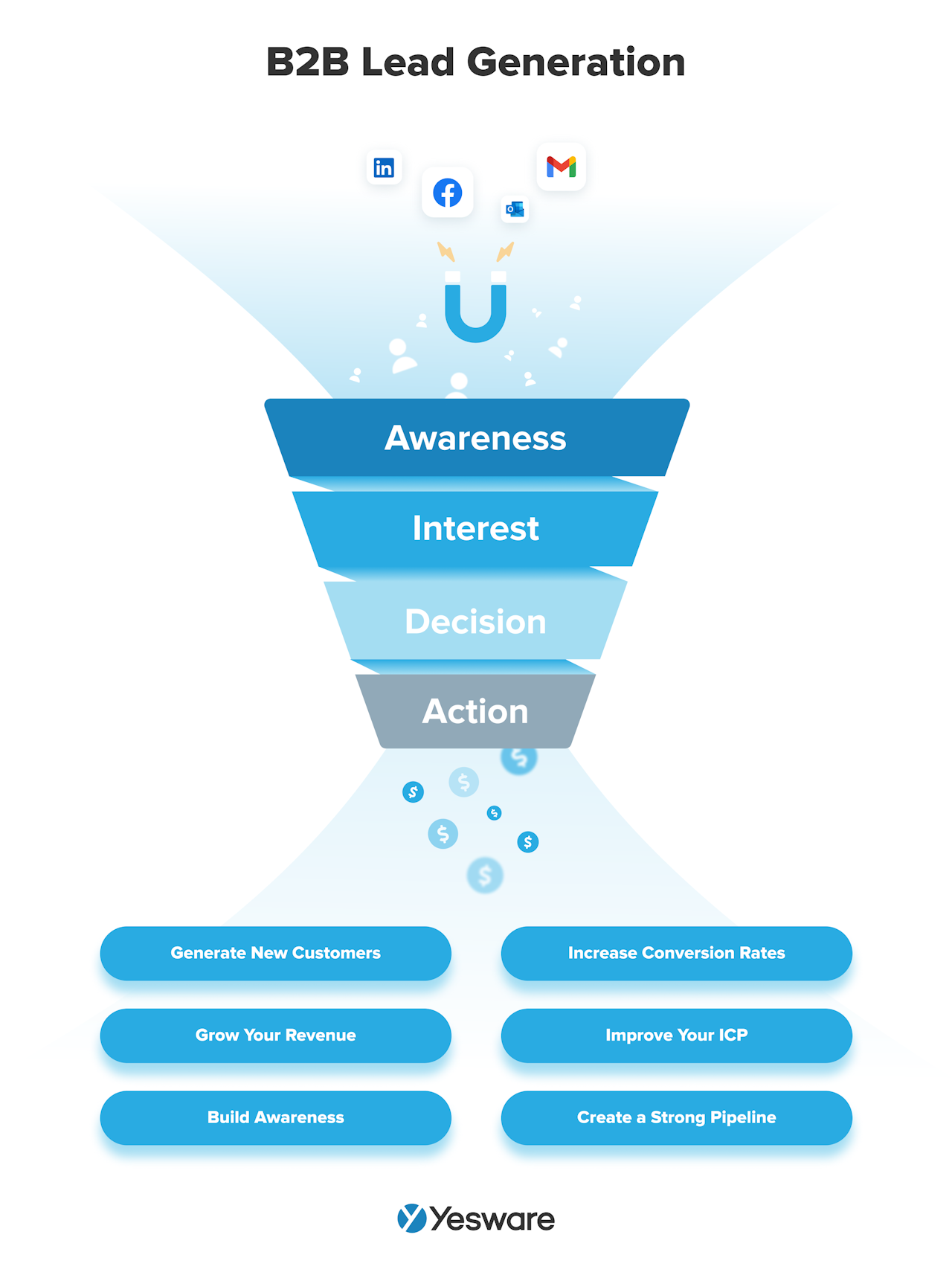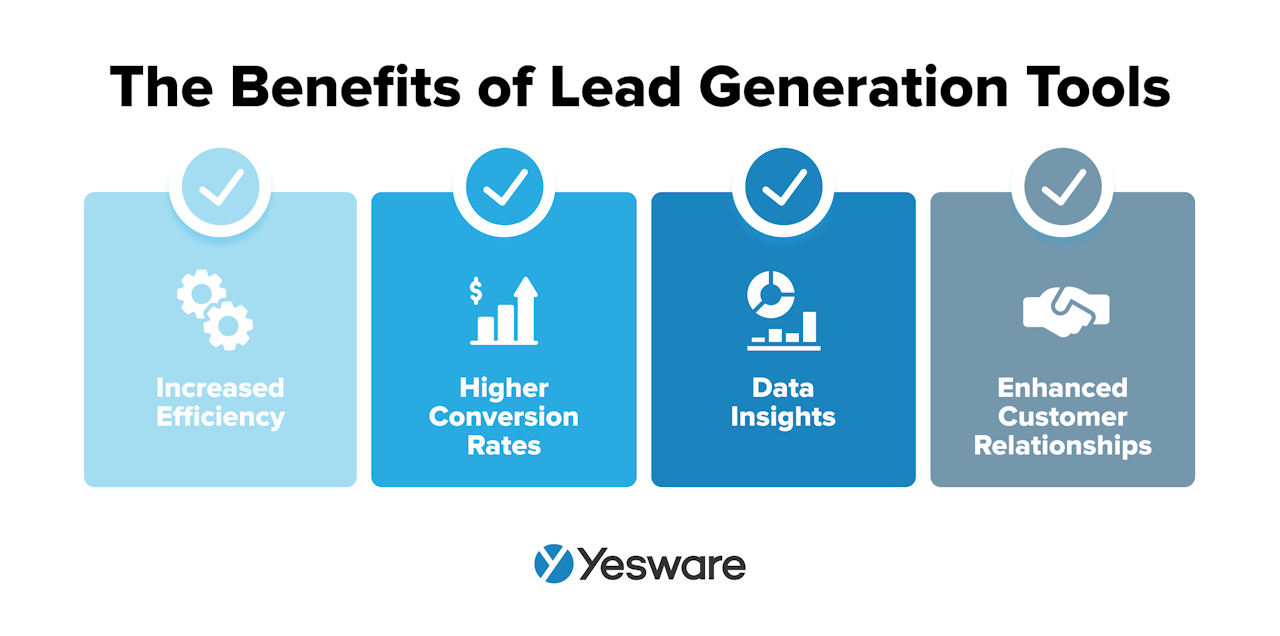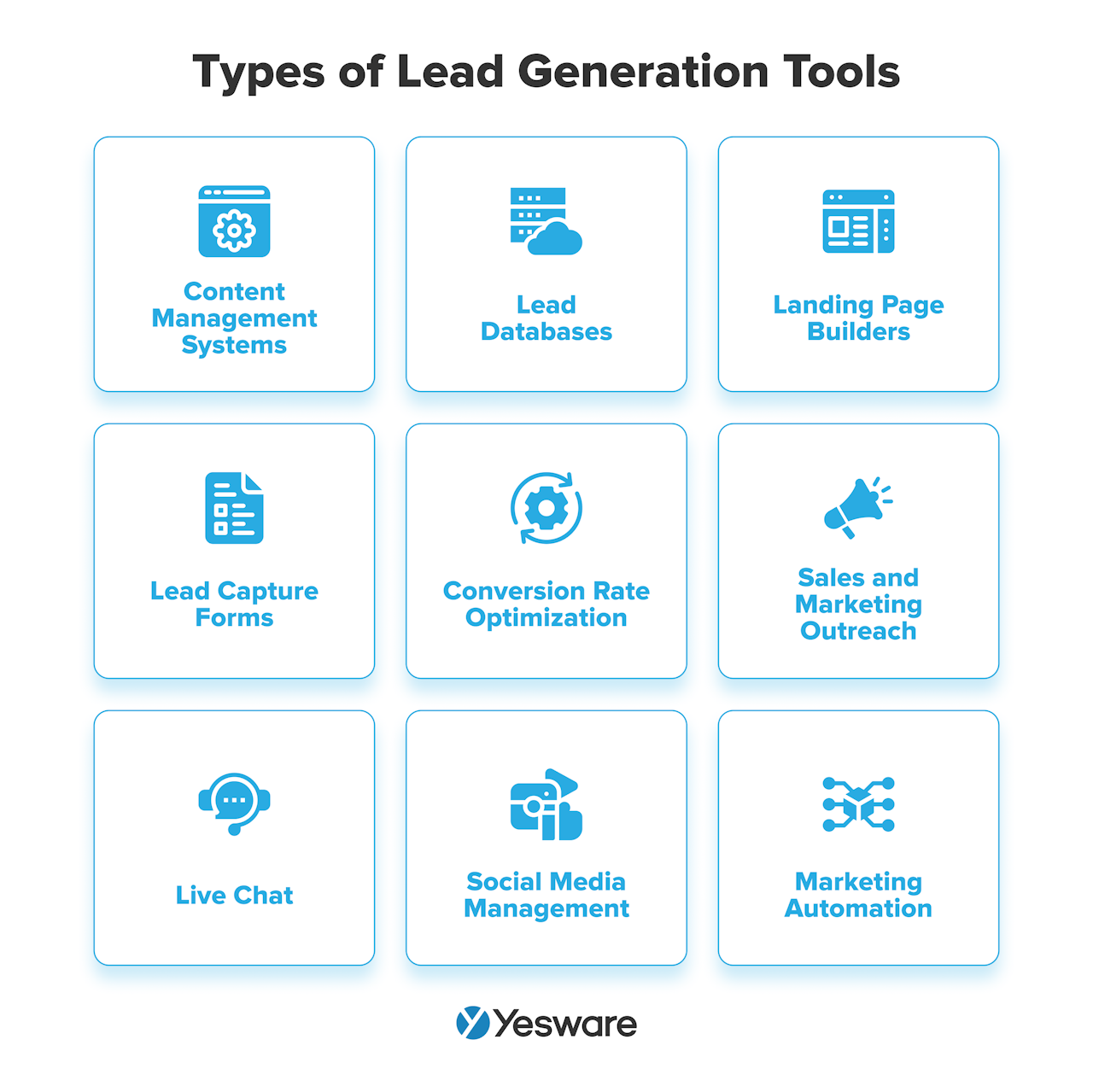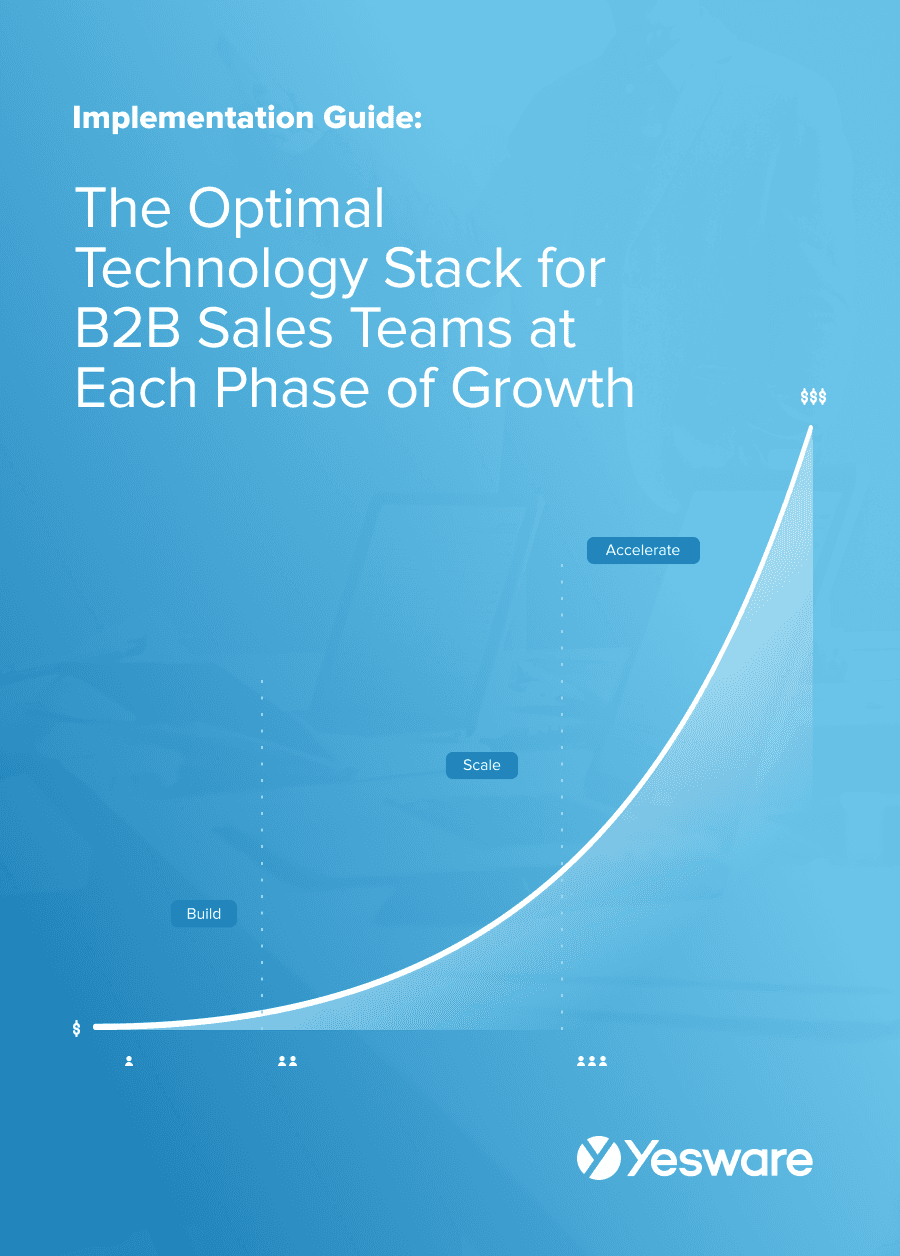37 Best Lead Generation Tools for Success in 2023
Casey O'Connor
Lead generation is one of the most important parts of a salesperson’s job. In fact, 85% of B2B companies report it being their most important goal.
Unfortunately, over 60% also view lead generation as their biggest challenge.
The good news is that there are plenty of lead generation tools available today that can help sales reps and marketers navigate the process. These software platforms can be amazingly powerful with all kinds of capabilities, from content management to email campaigns to landing page design.
In this article, we’ll go over everything you need to know about how to best leverage lead generation tools in today’s digital sales landscape, including the different types (with recommendations for a few of our favorites of each) and how to choose the right platform(s) for your team.
Here’s what we’ll cover:
- What Is a Lead Generation Tool?
- Importance of Lead Generation in B2B
- The Role of Tools in Streamlining Lead Generation
- Types of Lead Generation Tools + Examples
- How to Choose the Right Lead Generation Tool
What Is a Lead Generation Tool?
A lead generation tool is a software platform that helps B2B businesses identify, attract, and engage with potential buyers in their target market (leads).
Lead generation tools can help sales reps and marketers with a number of different components of the lead generation process. Depending on its specific features and capabilities, a lead generation tool can help add automation and data to any of the following processes (and more):
- Content management
- Landing page creation
- B2B lead database generation and management
- Lead magnets
- Lead capture forms
- CRO tools
- Email marketing
- Live chat
- Social media management
- Marketing automation
Regardless of its individual capabilities, the ultimate goal of each lead generation tool is to streamline and automate the B2B lead generation process.  This gives marketers the time they need to design impactful campaigns, and sales reps the bandwidth they need to create meaningful, value-driven relationships with best-fit leads.
This gives marketers the time they need to design impactful campaigns, and sales reps the bandwidth they need to create meaningful, value-driven relationships with best-fit leads.
Importance of Lead Generation in B2B
Lead generation is the ongoing process of identifying, attracting, and qualifying potential customers.
Lead generation efforts usually include capturing the lead’s contact information, as well as information about their preferences and behavior.
The ultimate goal of lead generation is to identify high-quality prospects who will eventually convert into customers.
Lead generation is one of the most important parts of the sales process. It serves as the foundation of sales, revenue, and profit growth by helping marketing and sales teams identify, attract, and make meaningful relationships with leads.
Despite how critical it is to the sales process overall, lead generation still presents a huge challenge for over two-thirds of B2B organizations.
Fortunately, sales and marketing teams have plenty of lead generation tools available to them that can streamline and optimize the lead generation process.
The Role of Tools in Streamlining Lead Generation
Lead generation tools can offer a huge ROI when it comes to streamlining the process of generating a steady, predictable flow of good-fit leads.

Increased Efficiency
Lead generation tools were built to add automation to the lead generation process, which can get surprisingly complex in a hurry.
When lead generation software platforms do the heavy lifting of creating, managing, and analyzing all of the many components of lead generation (including the extremely laborious task of collecting, managing, and aggregating the ridiculous amount of B2B lead data created during the process), sales reps can spend their limited time on building meaningful relationships and creating personalized sales campaigns for each lead.
Lead generation tools help increase overall rep productivity and improve the efficiency of the sales cycle.
Higher Conversion Rates
Lead generation tools provide sales teams with a steady stream of well-qualified leads by optimizing marketing campaigns and improving the efficiency of capturing qualified lead data.
This, in turn, leads to better conversion rates by the sales funnel stage, as well as better close rates overall.
Data Insights
One of the biggest benefits of lead generation tools is that they can collect, store, manage, and analyze large amounts of B2B lead data, including:
- Firmographic data
- Demographic data
- Technographic data
- Behavioral/Intent data
All of this information gives B2B sales teams significant leverage when it comes to managing lead relationships and nurturing each lead with targeted information related to where they are in the buying process. This insight can improve results across the sales funnel.
Enhanced Customer Relationships
The data insights that lead generation tools provide to sales and marketing teams can help them create hyper-personalized relationships with buyers.
The importance of this personalization cannot be understated in today’s market. B2B buyers consider personalization a non-negotiable in the sales process and have no problem abandoning brands that don’t make the effort to provide it.

A lead generation tool helps sales reps collect and coalesce the lead data that’s most relevant to the sales process and makes it easily accessible to them at the moment it matters most to each individual buyer relationship.
This kind of tool gives sellers a big leg up when it comes to building stronger relationships with prospects. Not only does this improve close rates, but it also enhances customer loyalty, boosts brand awareness, and improves customer retention and referral rates.
Types of Lead Generation Tools + Examples
There are many different types of lead generation tools, each with their own unique features and benefits. Some specialize in one feature and do it robustly, while others offer a suite of capabilities that can be customized to meet your team’s unique lead generation needs.
Following are the main types of lead generation tools, as well as a few examples of some of the most popular of each type.

Content Management Systems (CMS) For Websites and Blogging
Content Management Systems (CMS) are a must for sales and marketing teams that use blog content as part of their sales collateral.
Though they’re particularly helpful for teams that publish or distribute written content like blog posts, newsletters, whitepapers, etc., they can also be beneficial even for basic website management.
The true job of a CMS is to allow sales and marketing teams to optimize their buyers’ digital experience.
Following are a few of the most well-known CMS platforms:
1. WordPress
WordPress is known for its simplicity and allows users to publish web pages and content with confidence and ease. You can schedule posts in advance, collect data on visitor engagement, customize your content with a plethora of plug-ins, and more.
And, thanks to its popularity, WordPress offers a robust user community that can provide creative and technical support.
2. Joomla
Joomla lets users build websites and other content for free. Powered by a community of volunteers, the platform is designed for users who have at least a basic understanding of code and how to build web pages.
3. Wix
Wix is another popular website-creation platform that offers cloud-based web development services with easy-to-use drag-and-drop editing features. It allows users to easily add-on features for social media, online marketing, email marketing, lead capture forms, and more.
4. Drupal
Drupal is a free CMS platform that offers a strongly-accessible system to house your team’s content. This CMS helps its customers spur engagement and drive conversions.
5. Hubspot CMS
Hubspot CMS is called CMS Hub and gives marketers, developers, and buyers a seamless content experience.
It allows users to build pages customized for each visitor, optimized for conversion across every device.
With features like drag-and-drop, themes, and templates, and complete integration, webpage creation can be as simple or as complex as users prefer.
B2B Lead Database Tools
A B2B lead database tool helps sales and marketing teams collect, store, manage, and organize information about potential buyers.
This information could include firmographic, demographic, technographic, or behavioral data, and helps sellers approach each buyer with as much information as possible.
Following are a few of our favorite B2B lead database tools:
6. Yesware
Yesware is sales reps’ one-stop shop for managing all of their relevant lead data. Yesware’s Prospector tool offers access to a database of over 100+ million lead profiles, full of enriched data. This allows reps to generate new leads (and capture their most up-to-date, accurate data) in bulk.
And with advanced filters, and access to data directly in your Gmail or Outlook inbox, sales reps have every detail they need, right at their fingertips.
7. LinkedIn
LinkedIn’s Sales Navigator gives sellers advanced lead searches, intuitive CRM integrations, and subscription features like Job Seeker and LinkedIn Learning.
This lead database allows teams to target specific people and/or companies, build custom lead lists, and set alerts for lead behavior triggers.
8. ZoomInfo
ZoomInfo is a B2B lead database that gives users real-time data and insights. It helps connect sales reps with their best-fit customers, accelerating their growth.
It also has dynamic signal features that alert sales reps when their buyers do certain things on the web, like visit their pricing page or download a lead magnet.
Landing Page Builder
A landing page is a specific webpage that visitors land on after clicking on a carefully curated link you provided from an email or other marketing resource.
When visitors arrive at your landing page, they are enticed to exchange their contact information for some kind of gated, high-value content.
The goal of a landing page is to capture lead data and drive conversions.
A landing page builder helps even the least tech-savvy sales reps and marketers design sophisticated, high-converting landing pages that make a great first impression and quickly and non-intrusively collect lead information.
Here are a few of our favorite landing page software platforms:
9. Unbounce
Unbounce uses AI to help its users build landing pages that can improve conversion rates by an average of 30%.
With features that can design pop-ups, write compelling copy, and track and optimize conversion results, Unbounce is a powerful tool that is flexible enough to meet the various needs of many different sales and marketing teams.
10. Clickfunnels
Clickfunnels is another well-known landing page and funnel design platform that helps marketing and sales teams streamline their lead generation and nurturing processes.
This tool helps drive well-qualified potential buyers to your website from places like Facebook, YouTube, Instagram, TikTok, and more. It also includes A/B testing capabilities and powerful analytics to help keep your team moving forward.
11. Convert Kit
ConvertKit is a marketing platform built primarily for creators (e.g., authors, musicians, bloggers, etc.). It helps its users grow their audience, automate their marketing efforts, and sell their digital products. Its landing page templates are free, fully customizable, and remarkably easy to use (no coding necessary).
12. Divi
Divi is a WordPress Page Builder that helps users create their website in real time with over 40 fully customizable drag-and-drop elements. It removes the guesswork of coding and back-end complexity and allows users to watch their webpage come to life in front of them as they build it themselves.
13. Instapage
Instapage is another landing page builder that uses AI to help its users create optimized, high-converting landing pages. Their AdMap feature connects ads to relevant landing pages, making a better experience for your web visitors, and their A/B testing reports deliver powerful insights for improving your visitors’ digital experience.
Instapage also offers incredible page-load speeds, which can be a key metric for bounce rates.
Lead Capture Forms
Platforms that help sellers and marketers build lead capture forms give users the flexibility to create customizable forms or pop-ups that are designed to collect information and help convert visitors to leads.
This kind of software also helps teams automate their responses to a lead’s interaction with a form.
Here are a few of our favorite lead capture forms:
14. Feathery
Feathery offers its users fully customizable forms, including clear branding on all of your templates, without the need for code or developers.
In addition to lead capture forms, Featherly also lets users build flows for signup, onboarding, payment, and more.
15. Google Forms
Google Forms is completely free and, much like its other software offerings, extremely intuitive and easy to use.
Some users report that this platform probably isn’t the best tool for lead generation on a large scale, but works well for things like surveys and basic contact information.
16. Contact Form 7
Contact Form 7 is a very well-known WordPress plugin.
It’s pretty simple to use, partially because it doesn’t include a lot of frills or extra features. If you’re looking for a very basic form creator tool that doesn’t require coding, this could be a good fit.
17. Popupsmart
Popupsmart’s most well-known feature is their “Conversion Optimization Toolkit,” a no-code set of tools to help users grow their email lists and increase engagement.
The platform is free to use and doesn’t even require an account to get started.
18. WPForms
WPForms is another WordPress plugin, known for its drag-and-drop ease of use and simple, streamlined interface. It uses AI and conditional logic to create highly responsive lead capture forms.
19. Gravity Forms
Gravity Forms is on the more complex end of lead capture tools, but with that complexity comes impressive power and capability.
This platform gives users a very high degree of customization and can integrate with just any other platform your team uses.
Tip: In addition to your lead generation tools, ensure your team is leveraging the right tools for every step of the sales process with our free ebook below:
 The Optimal Technology Stack for B2B Sales TeamsUsing data from the most successful business-scaling models, we designed a blueprint for the exact technology your business needs at each phase of growth.
The Optimal Technology Stack for B2B Sales TeamsUsing data from the most successful business-scaling models, we designed a blueprint for the exact technology your business needs at each phase of growth.
CRO Tools
A CRO (conversion rate optimization) tool helps sales reps and marketers collect data about how visitors behave on their website to subsequently improve the user experience and improve conversions.
CRO platforms usually include features and tools like heatmaps, behavior analytics, A/B testing, and personalization. They also might help sales and marketing teams send customer surveys about their experiences on your website. This anecdotal data can help you improve your bounce rate and conversions.
Here are some of the best CRO tools:
20. Optimizely
Optimizely specializes in A/B testing. It also helps teams manage and analyze their content, and improve their inbound marketing results.
21. Heap
Heap is a digital insights platform that gives sellers and marketers in-depth access to your customers’ digital journeys.
It’s designed to improve conversion and retention rates by helping teams improve specific aspects of their online presence and interactions in a way that their buyers will appreciate.
22. HotJar
HotJar is a heatmap and behavior analytics tool.
It provides its users with easy-to-understand visuals about the flow of the sales funnel, so sales reps can quickly spot bottlenecks and challenges. HotJar is free to get started.
23. Instapage
Instapage helps users create mobile-responsive, personalized, and high-converting landing pages at scale.
It also allows multiple team members to optimize campaigns at the same time with easy collaboration tools, so the process of improving your web pages is streamlined and collaborative.
Email Marketing and Sales Outreach Tools
Email marketing tools help sales reps and marketers conduct email outreach at scale.
These platforms give users the ability to create email templates, deploy multiple campaigns at the same time, and track recipient engagement.
Email marketing software adds automation to the process of email outreach, so each lead can receive a targeted nurture campaign that’s designed to meet their unique needs.
24. Yesware
Yesware’s outreach campaigns give sales reps the power to dispatch multiple email campaigns simultaneously, while tracking engagement data on each individual email (including any attached content), as well as the email series as a whole.
And with Yesware’s email template capabilities, sales reps can create a library of proven, winning email scripts that they can use on repeat.
25. Mailchimp
Mailchimp is another well-known email marketing tool that helps users create sophisticated, aesthetically creative email campaigns that are designed to increase clicks and conversions.
It also offers detailed analytics and reporting so that users can track the effectiveness of their campaigns.
26. ActiveCampaign
ActiveCampaign has a unique feature that gives each email recipient an “engagement score.” This helps marketers and sales reps prioritize leads and prospects who are ready to buy.
ActiveCampaign also provides its users with popup reminders in advance of important dates for recipients in their campaigns.
Live Chat
Live chat tools enable sales reps, marketers, and/or customer support teams to interact with prospects and customers in real-time as they’re interacting with your brand.
Some live chat tools offer basic text interactions, while others can be surprisingly powerful, allowing people in the chat to share images, videos, their screens in real-time, and even voice notes.
27. Drift
Drift encourages its users to skip generic lead capture forms, and instead use their direct chat tool to help personalize the process of getting to know a lead.
The tool also lets you start a chat via video, rather than text, which can go a long way in helping your website visitors trust that they’re talking to a real person (not a bot).
28. LiveChat
LiveChat offers omnichannel messaging with voice, video, and screen-sharing capabilities.
It also has a number of in-depth chat-related tools that make lead conversations much easier to track, including Chat Tags, chat archives, and chat ratings.
29. Zendesk
Zendesk has grown tremendously in popularity over the last several years. This platform actually has a full suite of customer satisfaction tools, including a live chat feature.
Powered by AI, Zendesk’s data-processing tools can help sales reps and marketers gain insights from their customer chats.
Social Media Management Platforms
It’s safe to say that social selling is here to stay. With Facebook, Instagram, Twitter, and LinkedIn all legitimate channels for sales, smart teams know that they need to put processes in place to manage their different platforms.
Social media management platforms help teams juggle the many different aspects of social selling (e.g., posting, sharing, interacting with likes and comments, etc.).
30. Buffer
Buffer is a social media toolkit that helps your team build an audience organically.
One of Buffer’s unique selling points is that it’s a “value-driven” company, which many users appreciate in a space that can often feel lawless and unregulated.
Buffer helps teams know what (and when) to post for maximum engagement, and will track the results to continuously optimize your process.
31. Hootsuite
Hootsuite gives sales reps and marketers a glimpse of all of their socials on a single dashboard.
With this platform, you can schedule up to a month’s worth of posts in advance, monitor engagement and conversation, and track brand mentions across platforms.
32. Sprout Social
Sprout is a unified social media management platform that helps teams use social media to strengthen their market position and grow revenue.
With AI and Machine Learning (ML) technology, Sprout has cutting-edge technology to help build your business without reinventing the wheel (or your tech stack).
33. Sendible
Sendible is a great option for organizations that already have a sizable social media following and want to take their social selling efforts to the next level.
The platform can help users create some seriously sophisticated social posts, with features like GIPHYs, Pexel, or Canva themes, that are friendly across devices.
Marketing Automation
Marketing automation tools do the heavy lifting in the marketing funnel. They add automation to processes that would otherwise be laborious and time-consuming, so marketers can focus on designing campaigns that resonate with their target audience.
These platforms help with processes like lead generation and scoring, upselling and cross-selling activities, A/B testing, and analytics and reporting.
34. Vendasta
Vendasta’s platform gives businesses everything they need to sell, market, bill, and fulfill—all within a single platform.
Vendasta’s marketing automation functionalities allow users to generate hyper-customized reports highlighting prospect pain points, send personalized campaigns at scale, expand their offering through an extensive marketplace, and more.
35. Hubspot
Hubspot’s marketing platform helps teams create visually-appealing email campaigns, improve SEO results for their webpages, and boost qualified lead generation.
Also included are features like live chat, pop-up forms, landing pages, and reporting and analytics.
36. Marketo Engage
Adobe’s Marketo Engage focuses on tracking users’ behavior to more quickly qualify leads.
One of its most helpful features is its cross-channel tracking, meaning it can analyze the same user’s behavior across several different social media platforms to generate better insight into your channel performance and buyer preference.
It brings personalization to what can otherwise be an anonymous process.
37. Pardot
Pardot is a well-known lead generation tool that helps teams grow their reach and make more sales.
The platform includes tools to help marketers create landing pages, embedded forms, email campaigns, and more.
Tip: Looking for more tools?
How to Choose the Right Lead Generation Tool
The right lead generation tool for your team will ultimately depend on the age of your business, its overall goals, and the strengths and needs of your marketing and sales teams.
That being said, there are a few things that every team should evaluate as they consider the right generation tool to meet their needs.
Ease of Use
Perhaps the most important aspect of any lead generation tool is how easy it is to use. If the tool is too complex or out-of-date, it’s very unlikely that it will be readily adopted.
If there are any doubts about whether the tool is intuitive enough for your team members to use it to its fullest capacity, make sure you hold training on the software for anyone who needs it.
Integration
It’s also important that your lead generation tool integrates with your current tech stack.
The point of lead generation software is to grow your business; if you’re having to reinvent the (tech) wheel because of your new tool, it’s counterproductive to the growth goal.
Accessibility
Most lead generation tools now are cloud-based and can be accessed from anywhere with an internet connection.
In today’s world of remote work, it’s important that the platform you choose can be accessed by anyone who needs it, anywhere they are.
Affordability
It’s also important, of course, to consider your budget when you’re shopping for a lead generation tool.
It can be helpful to make a list of priorities for what you’re looking for in a lead generation tool, and evaluate those versus the cost for each of your options.
Support
The final factor to consider in choosing a lead generation tool is the support offered through the platform.
Depending on how complex the software is, you may find that you need access to live, in-person support for any number of issues.
At the very least, all lead generation software platforms should have thorough documentation on how to use and troubleshoot it.
Do you use any lead generation tools? Which has been most productive for your team? What tools might help you in the future as your business grows?
Get sales tips and strategies delivered straight to your inbox.
Yesware will help you generate more sales right from your inbox. Try our Outlook add-on or Gmail Chrome extension for free, forever!
Related Articles
Casey O'Connor
Casey O'Connor
Casey O'Connor
Sales, deal management, and communication tips for your inbox

